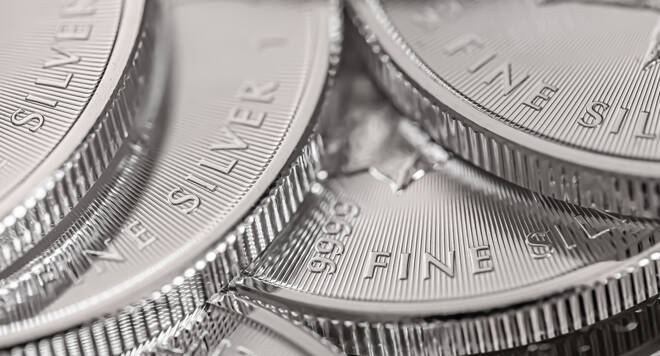Advertisement
Advertisement
Silver Is A Metal. Sometimes it’s Hot, Other Times It’s Not. Timing Is Crucial.
Published: Mar 31, 2021, 07:39 GMT+00:00
Silver is hot and some traders and commentators do not know how to describe its recent sharp appreciation.
- Silver could be a hot precious metal.
- But silver is also a commodity.
- The business cycle will help you decide when to buy it.
A review of recent history may be helpful. The above chart shows silver peaked in 2011 – like gold and copper – when the economy started to slow down. It kept declining during 2012-2016 even as the economy showed visible improvements during those years. It traded in a range from 2016 to 2020. It has more than doubled since then as the economy began to grow at a faster pace.
The above chart shows the graph of silver prices divided by gold prices. Silver has been weaker than gold from 2011 to 2020 as shown by the steady decline of the ratio during this period. Since March 2020 it has displayed considerable outperformance compared to gold (see above chart).
Every time the price of a commodity or precious metals rises rapidly it raises emotions. Price targets are raised quickly, making silver even more attractive. What are the reasons for its sharp rise? Will the trend continue? Are there better alternative investments in the commodity complex?
One way to find an answer is to look at what is the primary mover of commodity prices. Often, we are too involved with the technical reasons why prices change. More often than not, however, there are fundamental reasons. Prices change because business needs raw materials to produce goods. Other times their needs are not so pressing because of lower demand expectations.
The business cycle is the crucial development driving commodity prices. The business cycle is caused by the adjustment process of inventories as they are changed to adapt to the growth of sales. Business (and miners) do not react at once to a slowdown in sales. They prefer to keep producing, expecting a comeback in demand. This decision is based on keeping unit costs of production low by using plants at close to capacity.
The first reaction to a slowdown in demand is to cut prices hoping to stimulate demand. As the slowdown becomes more pronounced, business is forced to cut production in response to bloated inventories and lower earnings. Supply, in other words, is trying to catch up with weakening demand. The inventory cycle is the main driver of commodity prices.
The decision to cut inventories causes a reduction of the raw material purchases – and commodities decline. An increase in inventories, caused by stronger demand, forces business to increase raw material purchases – and commodity prices rise. This change in purchasing strategies drives commodity prices up or down depending on whether the business cycle is strengthening or weakening.
The main issue for traders and investors is, of course, when should I buy silver? Or should I buy an alternative investment in the commodity complex? The answer is given by the following chart.
The above chart shows the ratio of the price of XME (ETF holding metal and mining stocks) and the price of silver. The lower panel shows the Business Cycle Indicator, updated regularly for subscribers of The Peter Dag Portfolio Strategy and Management available on www.peterdag.com. (A complimentary issue is available to readers of this article).
The relation between the two graphs is remarkable. It should provide an important strategic guide for investors interested in commodities and silver in particular.
The above relationship shows metals and mining stocks (XME) are likely to outperform silver (the ratio rises) when the economy grows faster as it did during 2012-2014, 2016-2018, and since March 2020.
Silver is likely to outperform metals and mining stocks (XME) (the ratio declines) when the business cycle shows the economy slowing down as it did during 2011-2012, 2014-2016, and 2018-2020.
Key takeaways
Silver has important cyclical features.
Silver becomes more attractive than XME when the economy slows down.
It becomes unattractive compared to XME when the economy strengthens as it did since March 2020.
In a stronger economic environment metals and mining stocks (XME) are considerably more attractive than silver.
XME will continue to outperform silver as long as the Business Cycle Indicator rises, reflecting a stronger economy.
About the Author
George Dagnino, PHDcontributor
George Dagnino, PhD, is chairman of Peter Dag Strategic Money Management. As the former chief economist and risk manager for Goodyear, he managed $4 billion of interest rates and currency hedge portfolios.
Advertisement
